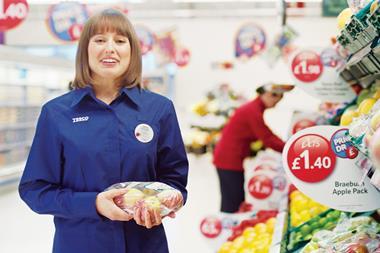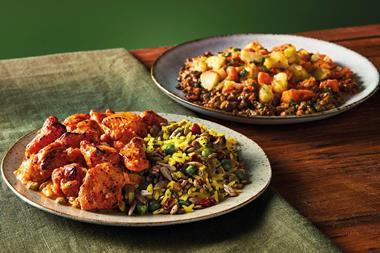How much anti-supermarket sentiment lies behind a selling strategy focusing on identity and integrity asks Mike Ingham
Shortening the marketing chain is suddenly fashionable as one suggested remedy for the ills of Scotland's meat industry. Let the livestock farmer or the craft carcase butcher communicate more directly with the shopper or the restaurant diner, and it will supposedly be possible to restore the morale and margin sapped from the beef, lamb and pork sectors.
Identity and integrity of the meat, and of the people who produce it, are said to be the themes essential in a clearer message straight from the farms of Scotland to even distant consumers.
Distinctive character will, it is claimed, give the commodity a commercial edge when increasingly fastidious buyers feel frustrated in an overcrowded marketplace with a distribution system that they believe has lost some of its transparency.
Sharper images of producers with pride in their livestock husbandry and of processors skilled in maximising the eating quality of carcase cuts are intended to demonstrate the value conferred by experience and expertise as well as the more emotive appeal of beautiful locations.
Despite its logic, this marketing strategy causes unease both within Scotland's industry and among major buyers outside. The multiples, especially, can interpret it as an attack on their purchasing policies and margins. Talk of a need for closer links between producers and consumers, and for heavier emphasis on the geographical source of meat, is familiar as a coded allegation of extortionate mark-ups between farmgate and retail counter or of "unfair" competition from imports.
Supermarket suspicions were apparently confirmed recently in a widely reported call from Scottish NFU livestock committee chairman David Mitchell for the marshalling of "consumer power" because producers had to "face the fact it is one of the few methods we have of challenging the power exerted by the big retail outlets".
Mitchell was voicing an opinion held by many livestock producers in Scotland, and by some processors. Anti-supermarket sentiment even appears stronger in the corporate sector of Scotland's beef industry than in England. The successful Inverurie based processor Scotch Premier has gained status in the marketplace since publicly redefining its main role to focus sharply on supplying the top ends of independent retail and catering chains, supposedly turning its back on the multiples.
The same disturbing message for the supermarkets seemed to emerge from one of the first major intitiatives by the new promotional organisation Quality Meat Scotland just a few weeks ago. QMS launched a campaign to boost brand awareness of Scotch beef in the catering sector, with southern England the main target market.
QMS promotions manager Vic Prow was widely quoted as describing catering as "the one major area of growth for the red meat sector".
The move was welcomed in Scotland, and not only by farmers, as an overdue attempt to evade the supposedly margin-hungry multiples and instead establish shorter supply routes to the end market, boosting the price premium at point of sale and ensuring a bigger proportion of the added value associated with the Scottish brand could be retained by processors and producers.
Up to a point, all this is a manifestation of the financial tensions that have developed along the livestock and meat production and marketing chain throughout the UK in recent years, first due to the BSE crisis devastating the beef sector in 1995-96 and then with the sheep and pig price collapses.
Scotland's livestock farmers, despite being generally acknowledged as among the most efficient in Europe, have seen their net incomes virtually wiped out since the mid 1990s.
The meat processing sector, too, has suffered a series of high profile casualties, notably the financial disasters at the Lockerbie, Buchan and Perth plants which caused losses for livestock supplier creditors, and closure of ANM's Edinburgh slaughtering operation (although that did not impose direct financial costs on farmers).
In some important respects the Scottish meat sector differs from the industries of England, Wales and Northern Ireland, and has perhaps suffered more because its traditional competitive strengths have, ironically, increased its vulnerability.
"We were so far ahead of the rest of the UK industry... but the others have done a lot of catching up, and some of what they have achieved has been spectacular," says one of the Scottish meat sector's most respected participants, Broxburn processor and wholesaler Neil Stoddart. "We became production led, and maybe now we need to become more market led."
Stoddart chooses his words with great care, and not only because meat industry politics demand discretion. The economic structures of Scotland's livestock and meat sectors are both causes and effects of marketing traditions and pressures, and the reciprocal influences can easily be misinterpreted.
The anti-supermarket sentiment, for instance, is not the same in Scotland as retailers are accustomed to encountering on the other side of the border.
Whereas English and Welsh farmers can be bitterly resentful of the multiples, the Scots' attitude is more robustly adversarial.
This is hardly surprising, as the Scottish livestock and meat industries are, by tradition, export sectors, long conscious of being dependent on fastidious and fickle big customers in the distant market of southern England.
On the other hand, the Scots had until recently a well justified sense of security, at least in their beef sector. Vulnerable they may have been to the whims of buyers hundreds of miles away, but those purchasers knew they were getting a high quality commodity from a highly efficient industry, and this awareness was reflected in a persistent price premium for Scotch beef in the London wholesale trade long before butchers had heard of such terms as "added value" or "niche markets".
With the possible exception of Welsh lamb, no other UK meat acquired an international identity anywhere near matching Scotland's beef.
The big payoff came in the first half of the last decade, when Scottish suppliers opened up the Continental markets for clean beef. ( British' beef exports were in fact mostly of cow carcases or cuts for manufacturing, unlike the Scots' quality meat for Italian restaurant tables.)
Then came BSE, and in 1996, the export ban. Of course, the past four years of chaos in the Scottish industry and the very recent relaunching of its main promotional vehicle, the former SQBLA in the new guise of Quality Meat Scotland, though without its highly regarded if sometimes outspoken commanding officer Brian Simpson, can be attributed to this catastrophe.
But the precise causes of the turmoil are not well understood outside Scotland, and even within the Scottish farming sector there is misinterpretation of why the export ban was so damaging and the reasons for the new beef marketing strategy (and for similar, parallel policies in the sheepmeat and pigmeat sectors.)
The end of exporting was not in itself an unsustainable shock. There was plenty of demand within the UK to absorb product diverted from continental markets.
The dangerous new stresses were more subtle, and indirect. BSE caused a "flight to quality" within the British beef market. All major retailers declared loyalty to home producers, but in return demanded unprecedented assurances of quality and safety.
Scotland's industry was already well able to provide these assurances and that was its downfall.
As the highly visible role models for successful marketing in the post-BSE era, the Scottish livestock and meat sectors have suffered from no doubt flattering but more importantly damaging imitation by suppliers from Yorkshire to Argentina.
The effect has been dilution of the brand value, especially for beef, even though the economic and structural advantages on which that brand was based have proved fairly resilient.
Latest official farm statistics show, for instance, Scotland's average beef suckler cow herd still near twice the size of England's at about 50 head. Despite the plant closures, the processing industry remains a sector mostly of quite large, efficient units, communicating market signals clearly and with a commercial culture well suited to the multiple retailers' needs.
Even Scotch Premier's image as anti-multiple is perhaps more style than substance; it has some major retailer business, and more significantly its sister company Yorkshire Premier pioneered seam-boned beef for further processing, and is still star of the ready meal raw material market which is very much the supermarkets' trade.
One of Neil Stoddart's competitors comments: "We need to get closer to the consumer, but that doesn't mean we're all going to be running farm shops."
Instead, the Scots are trying to strengthen their meat branding precisely because they, and their newcomer competitors, know that is precisely what the modern market demands.
{{SUPPLEMENTS }}
Close menu
- Home
- Retail & Wholesale
-
Products & Suppliers
- Back to parent navigation item
- Products & Suppliers
-
Product Categories:
- Back to parent navigation item
- Product Categories:
- Alcoholic drinks
- Bakery
- Cereals & breakfast
- Cheese
- Chicken & poultry
- Chocolate
- Confectionery
- Crisps, nuts & snacks
- Dairy
- Fish
- Fresh produce
- Frozen
- Household
- Meat
- Own Label
- Sauces & condiments
- Seasonal
- Soft drinks
- Vaping
- Vegan & plant-based
- World foods
- Suppliers
- People
- Reports & Data
-
Topics A-Z
- Back to parent navigation item
- Topics A-Z
-
Popular topics:
- Back to parent navigation item
- Popular topics:
- Cost of living crisis
- Crime
- Deposit Return Schemes
- Finance
- Government & Regulation
- Health
- Inflation
- Loyalty
- Marketing
- Mergers & Acquisitions
- New Product Development
- Sourcing
- Supply chain
- Sustainability & environment
- Technology
- Ultra Processed Foods
- Vaping
- A-Z all topics
- Content by type:
- Events
- Ask iA (beta)
- Subscribe now
Sign in to comment on this article
Not logged in before? Register for FREE guest access today.
You will be able to:
- Read more stories
- Receive daily newsletters
- Comment on stories
Advert
















No comments yet